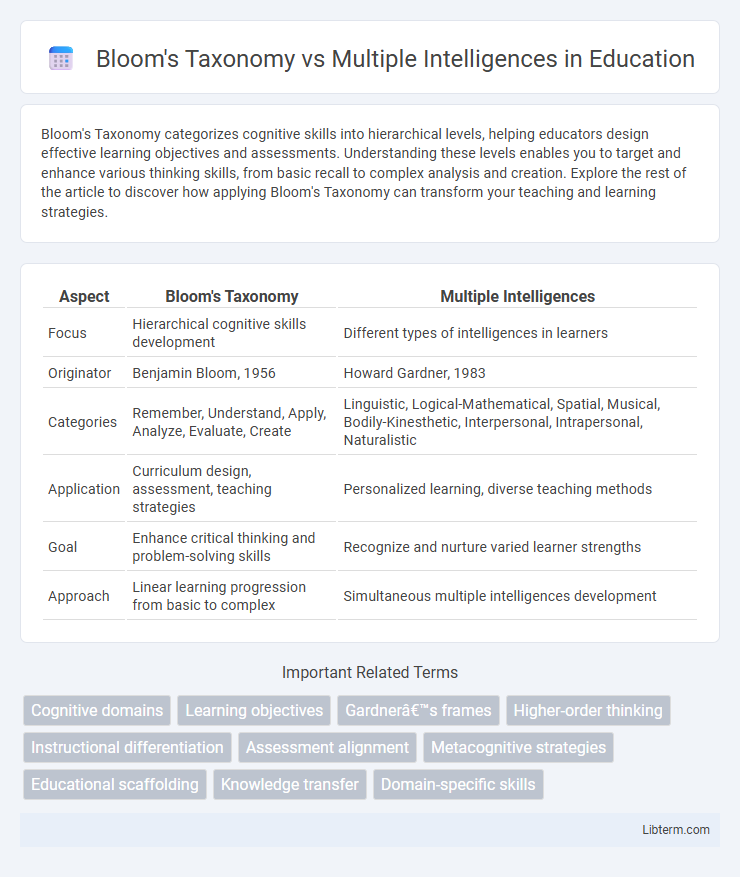Bloom's Taxonomy categorizes cognitive skills into hierarchical levels, helping educators design effective learning objectives and assessments. Understanding these levels enables you to target and enhance various thinking skills, from basic recall to complex analysis and creation. Explore the rest of the article to discover how applying Bloom's Taxonomy can transform your teaching and learning strategies.
Table of Comparison
| Aspect | Bloom's Taxonomy | Multiple Intelligences |
|---|---|---|
| Focus | Hierarchical cognitive skills development | Different types of intelligences in learners |
| Originator | Benjamin Bloom, 1956 | Howard Gardner, 1983 |
| Categories | Remember, Understand, Apply, Analyze, Evaluate, Create | Linguistic, Logical-Mathematical, Spatial, Musical, Bodily-Kinesthetic, Interpersonal, Intrapersonal, Naturalistic |
| Application | Curriculum design, assessment, teaching strategies | Personalized learning, diverse teaching methods |
| Goal | Enhance critical thinking and problem-solving skills | Recognize and nurture varied learner strengths |
| Approach | Linear learning progression from basic to complex | Simultaneous multiple intelligences development |
Introduction to Bloom's Taxonomy
Bloom's Taxonomy is a hierarchical classification of cognitive skills designed to promote higher-order thinking in education, structured into six levels: Remembering, Understanding, Applying, Analyzing, Evaluating, and Creating. Developed by Benjamin Bloom in 1956, it serves as a foundational framework for curriculum development, assessment design, and instructional strategies aimed at enhancing student learning outcomes. Unlike Multiple Intelligences theory, which focuses on diverse cognitive abilities across individuals, Bloom's Taxonomy emphasizes structured cognitive processes within educational objectives.
Overview of Multiple Intelligences Theory
Multiple Intelligences Theory, developed by Howard Gardner in 1983, identifies eight distinct types of intelligence: linguistic, logical-mathematical, spatial, musical, bodily-kinesthetic, interpersonal, intrapersonal, and naturalistic. Unlike Bloom's Taxonomy, which categorizes cognitive skills and learning objectives hierarchically, Multiple Intelligences emphasizes diverse human capabilities and learning styles beyond traditional academics. This theory promotes personalized education by recognizing that students possess various strengths and intelligences, encouraging differentiated instruction to enhance engagement and comprehension.
Historical Context and Development
Bloom's Taxonomy, developed by Benjamin Bloom in 1956, established a hierarchical framework for categorizing educational learning objectives, emphasizing cognitive processes from knowledge recall to evaluation. Multiple Intelligences theory, proposed by Howard Gardner in 1983, challenged traditional intelligence models by identifying distinct types such as linguistic, logical-mathematical, and spatial intelligences, highlighting varied human cognitive strengths. The development of Bloom's Taxonomy laid the groundwork for structured curriculum design, while Gardner's theory expanded educational approaches to accommodate diverse learner profiles.
Core Principles and Frameworks
Bloom's Taxonomy structures cognitive learning objectives into six hierarchical levels: Remembering, Understanding, Applying, Analyzing, Evaluating, and Creating, emphasizing progressive acquisition of knowledge and skills. Howard Gardner's Multiple Intelligences theory identifies eight distinct intelligences--Linguistic, Logical-Mathematical, Spatial, Musical, Bodily-Kinesthetic, Interpersonal, Intrapersonal, and Naturalistic--highlighting diverse ways individuals process information and demonstrate intelligence. The core principle of Bloom's framework centers on cognitive skill development, while Gardner's framework prioritizes personalized learning by recognizing varied intellectual strengths.
Application in Modern Education
Bloom's Taxonomy structures learning objectives into cognitive levels--remembering, understanding, applying, analyzing, evaluating, and creating--enabling educators to design curriculum that promotes higher-order thinking and practical skill development. Multiple Intelligences theory, proposed by Howard Gardner, emphasizes diverse cognitive strengths such as linguistic, logical-mathematical, spatial, and kinesthetic intelligences, encouraging teaching strategies tailored to individual learner profiles. Integrating Bloom's cognitive framework with Multiple Intelligences in modern education fosters personalized learning experiences that enhance engagement and accommodate varied intellectual capabilities, improving overall student achievement and critical thinking skills.
Comparing Cognitive Processes and Intelligence Types
Bloom's Taxonomy categorizes cognitive processes into hierarchical levels such as remembering, understanding, applying, analyzing, evaluating, and creating, which structure learning objectives by complexity. Multiple Intelligences theory identifies distinct intelligence types including linguistic, logical-mathematical, spatial, musical, bodily-kinesthetic, interpersonal, intrapersonal, and naturalistic, emphasizing varied cognitive strengths beyond traditional IQ. Comparing both frameworks highlights that Bloom's Taxonomy focuses on stages of cognitive skill development while Multiple Intelligences addresses diverse ways individuals process information and demonstrate intellectual abilities.
Strengths and Limitations of Each Model
Bloom's Taxonomy excels in providing a hierarchical framework for categorizing cognitive skills, promoting clear learning objectives and assessment strategies, but it primarily emphasizes cognitive processes and may overlook emotional or social dimensions of learning. Multiple Intelligences theory highlights diverse learner strengths across linguistic, logical-mathematical, spatial, interpersonal, and bodily-kinesthetic domains, broadening educational inclusivity though it can lack empirical rigor and pose challenges for standardized assessment. Both models serve complementary roles: Bloom's Taxonomy structures educational goals while Multiple Intelligences addresses varied learner profiles, yet each has limitations in fully capturing the complexity of human intelligence and learning.
Impact on Teaching Strategies
Bloom's Taxonomy structures teaching strategies by categorizing cognitive skills into hierarchical levels, guiding educators to design lessons that progressively develop critical thinking and problem-solving abilities. Multiple Intelligences theory expands teaching strategies to address diverse learner strengths, encouraging varied instructional methods such as visual aids, kinesthetic activities, and interpersonal tasks. Combining both frameworks enhances personalized learning by aligning cognitive skill development with individual intelligence profiles, improving student engagement and comprehension.
Assessment and Evaluation Methods
Bloom's Taxonomy emphasizes hierarchical cognitive skills from remembering to creating, guiding structured assessment design that measures specific learning objectives through formative and summative evaluations. Multiple Intelligences theory advocates for diverse assessment methods reflecting varied learner strengths, including linguistic, spatial, musical, and kinesthetic intelligence assessments through projects, performances, and portfolios. Combining both frameworks enhances evaluation by aligning cognitive skill development with individualized intelligence profiles, ensuring comprehensive and inclusive student assessment.
Integrating Both Theories in the Classroom
Integrating Bloom's Taxonomy with Gardner's Multiple Intelligences in the classroom enhances differentiated instruction by targeting diverse cognitive levels and varied intelligence types such as linguistic, logical-mathematical, and kinesthetic. Employing Bloom's hierarchical cognitive domains--remembering, understanding, applying, analyzing, evaluating, and creating--alongside multiple intelligences ensures lesson plans accommodate students' unique learning strengths and encourage deeper comprehension. This combined approach fosters engagement, critical thinking, and personalized learning, leading to more effective educational outcomes.
Bloom's Taxonomy Infographic

 libterm.com
libterm.com